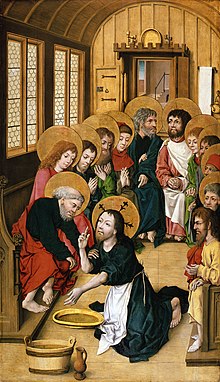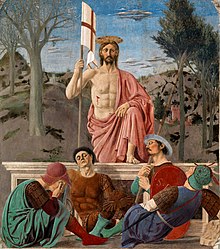
The liturgical year, also called the church year, Christian year or kalendar, consists of the cycle of liturgical seasons in Christian churches that determines when feast days, including celebrations of saints, are to be observed, and which portions of Scripture are to be read either in an annual cycle or in a cycle of several years.
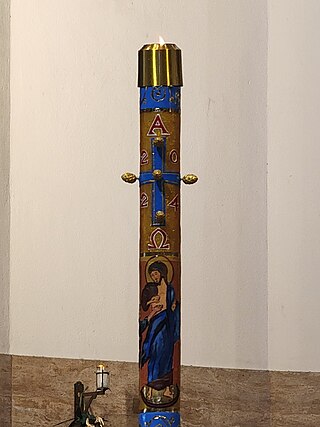
A Paschal candle is a large, white candle used in liturgies in Western Christianity. A new Paschal candle is blessed and lit every year at Easter, and is used throughout the Paschal season which is during Easter and then throughout the year on special occasions, such as baptisms and funerals.
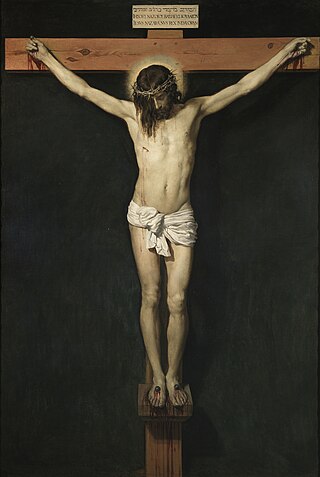
Good Friday is a Christian holy day observing the crucifixion of Jesus and his death at Calvary. It is observed during Holy Week as part of the Paschal Triduum. It is also known as Black Friday, Holy Friday, Great Friday, Good Friday of the Passion of the Lord,Great and Holy Friday.
In the liturgical calendar of the Roman Rite, a solemnity is a feast day of the highest rank celebrating a mystery of faith such as the Trinity, an event in the life of Jesus, his mother Mary, his earthly father Joseph, or another important saint. The observance begins with the vigil on the evening before the actual date of the feast. Unlike feast days of the rank of feast or those of the rank of memorial, solemnities replace the celebration of Sundays outside Advent, Lent, and Easter.

Liturgical colours are specific colours used for vestments and hangings within the context of Christian liturgy. The symbolism of violet, blue, white, green, red, gold, black, rose and other colours may serve to underline moods appropriate to a season of the liturgical year or may highlight a special occasion.
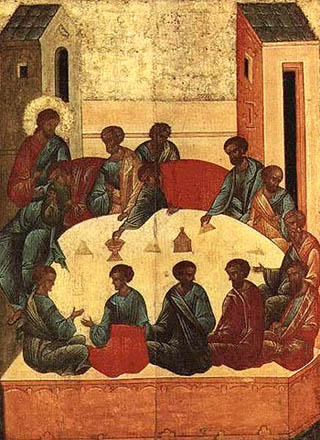
Maundy Thursday or Holy Thursday, among other names, is the day during Holy Week that commemorates the Washing of the Feet (Maundy) and Last Supper of Jesus Christ with the Apostles, as described in the canonical gospels.

Holy Week is the most sacred week in the liturgical year in Christianity. For all Christian traditions, it is a moveable observance. In Eastern Christianity, which also calls it Great Week, it is the week following Great Lent and Lazarus Saturday, starting on the evening of Palm Sunday and concluding on the evening of Great Saturday. In Western Christianity, Holy Week is the sixth and last week of Lent, beginning with Palm Sunday and concluding on Holy Saturday.

Holy Saturday, also known as Great and Holy Saturday, Low Saturday, the Great Sabbath, Hallelujah Saturday, Saturday of the Glory, Sábado de Gloria, and Black Saturday or Easter Eve, and called "Joyous Saturday", "the Saturday of Light", and "Mega Sabbatun" among Coptic Christians, is the final day of Holy Week, between Good Friday and Easter Sunday, when Christians prepare for the latter.
The Octave of Easter is the eight-day period, or octave, that begins on Easter Sunday and ends with Second Sunday of Easter. It marks the beginning of Eastertide. The first seven of these eight days are also collectively known as Easter Week.
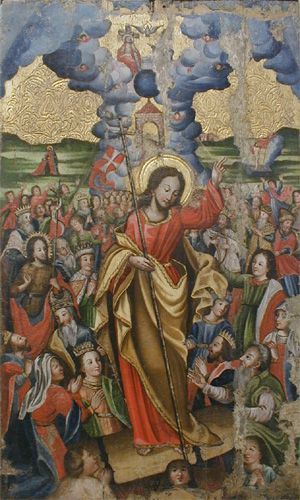
Eastertide or Paschaltide is a festal season in the liturgical year of Christianity that focuses on celebrating the Resurrection of Jesus Christ. Preceded by Lent, it begins on Easter Sunday, which initiates Easter Week in Western Christianity, and Bright Week in Eastern Christianity.
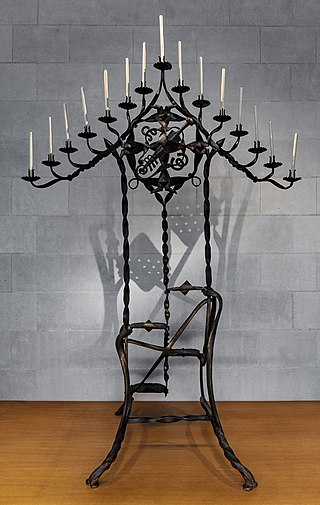
Tenebrae is a religious service of Western Christianity held during the three days preceding Easter Day, and characterized by gradual extinguishing of candles, and by a "strepitus" or "loud noise" taking place in total darkness near the end of the service.
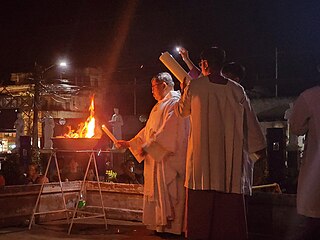
The Easter Vigil, also called the Paschal Vigil, the Great Vigil of Easter, or Holy Saturday in the Easter Vigil on the Holy Night of Easter is a liturgy held in traditional Christian churches as the first official celebration of the Resurrection of Jesus. Historically, it is during this liturgy that people are baptized and that adult catechumens are received into full communion with the Church. It is held in the hours of darkness between sunset on Holy Saturday and sunrise on Easter Day – most commonly in the evening of Holy Saturday or midnight – and is the first celebration of Easter, days traditionally being considered to begin at sunset.

In the Roman Rite of the Catholic Church, Lutheranism, Methodism and Anglicanism, an altar bell is typically a small hand-held bell or set of bells. The primary reason for the use of such bells is to create a “joyful noise to the Lord” as a way to give thanks for the miracle taking place atop the altar.

The Mass is the central liturgical service of the Eucharist in the Catholic Church, in which bread and wine are consecrated and become the body and blood of Christ. As defined by the Church at the Council of Trent, in the Mass "the same Christ who offered himself once in a bloody manner on the altar of the cross, is present and offered in an unbloody manner". The Church describes the Mass as the "source and summit of the Christian life", and teaches that the Mass is a sacrifice, in which the sacramental bread and wine, through consecration by an ordained priest, become the sacrificial body, blood, soul, and divinity of Christ as the sacrifice on Calvary made truly present once again on the altar. The Catholic Church permits only baptised members in the state of grace to receive Christ in the Eucharist.
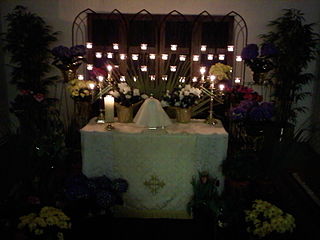
The altar of repose is a temporary altar where the Communion hosts consecrated on Maundy Thursday during the Mass of the Lord's Supper are placed, or "reserved", for use on the following day, Good Friday.

The Mass of the Lord's Supper, also known as A Service of Worship for Maundy Thursday, is a Holy Week service celebrated on the evening of Maundy Thursday. It inaugurates the Easter Triduum, and commemorates the Last Supper of Jesus with his disciples, more explicitly than other celebrations of the Mass.

Lent is the solemn Christian religious observance in the liturgical year commemorating the 40 days Jesus spent fasting in the desert and enduring temptation by Satan, according to the Gospels of Matthew, Mark and Luke, before beginning his public ministry. Lent is usually observed in the Catholic, Lutheran, Moravian, Anglican, United Protestant and Orthodox Christian traditions, among others. Some Anabaptist, Baptist, Methodist, Reformed, and nondenominational Christian churches also observe Lent, although many churches in these traditions do not.
The Easter cycle is the sequence of the seasons and days in the Christian liturgical year which are pegged to the date of Easter, either before or after it. In any given calendar year, the timing of events within the Easter cycle is dependent on the calculation of the date of Easter itself.

The Stripping of the Altar or the Stripping of the Chancel is a ceremony carried out in many Catholic, Lutheran, Methodist, and Anglican churches on Maundy Thursday.

A crotalus, also known as a crotalum or clapper, is a wooden liturgical rattle or clapper that replaces altar bells during the celebration of the Tridentine Paschal Triduum at the end of Lent in the Catholic Church. It is also occasionally used during the celebration of the Ordinary Form Roman Missal during the Paschal Triduum, but its popularity decreased following the liturgical reforms of the Second Vatican Council. The crotalus is also sometimes used in Episcopal Church parishes.
